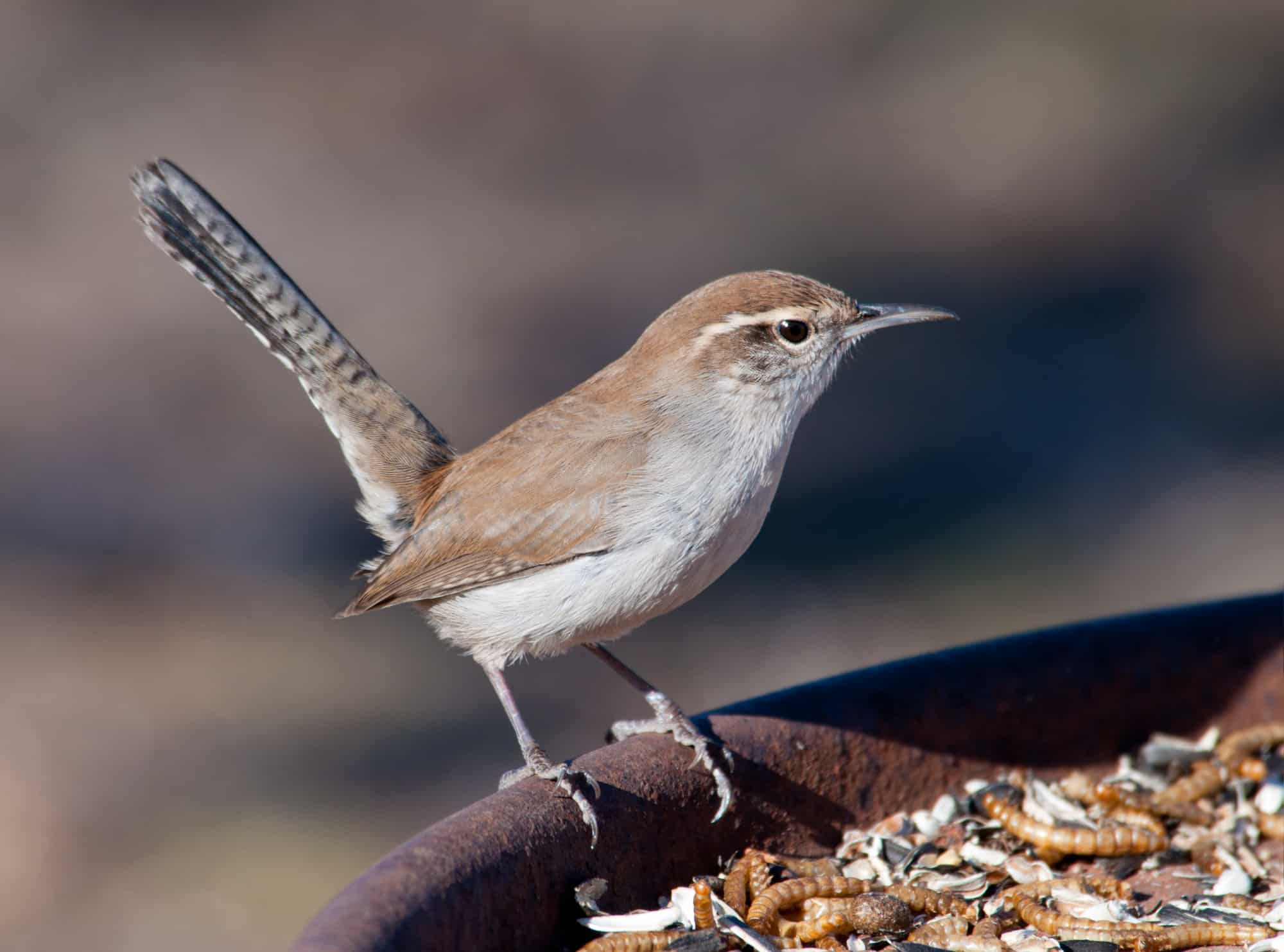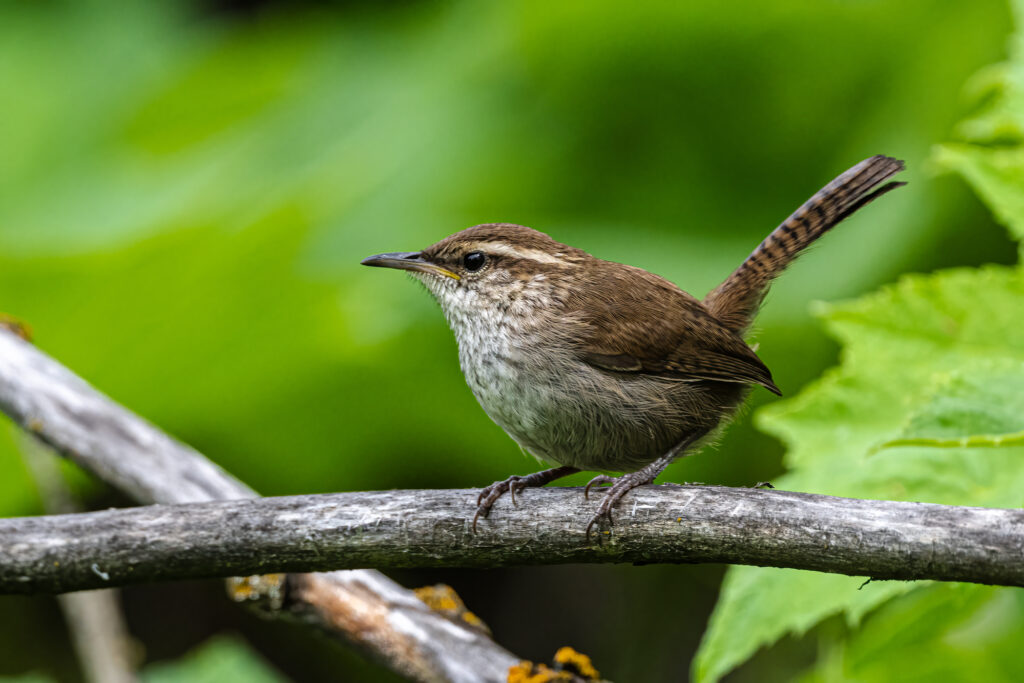Minnesota. A land of lakes, swamps, and forests, not forgetting extensive farmlands and big cities, too. Bar Alaska, Minnesota is the northernmost state in The Union.
With its northerly interior position, Minnesota has warm summers and very cold winters. Over the last hundred years, Minnesota has recorded a maximum temperature of 114°F and a minimum of -60°F!
In this extreme climate, not so many birds stick around for winter, and wrens are no exception. Almost all reports of wrens occur during the spring and summer breeding season here.
It’s during this time of the year that wrens are at their most tenacious, fiercely staking out their territories and hopping around noisily, scolding anyone or anything that approaches their nests.
Because wrens are chiefly insectivores, Minnesota residents can encourage wrens to visit their backyards by refraining from using pesticides. A quiet, brushy corner of the garden where weeds are allowed to grow will go a long way to encouraging these delightful birds to grace your home.
Wren Species in Minnesota, Starting With the Most Common
House Wren

- Scientific Name: Troglodytes aedon
- Length: 4.3-5.1 in (11-13 cm)
- Weight: 0.3-0.4 oz (10-12 g)
- Wingspan: 5.9 in (15 cm)
Reported by nearly one in four birdwatchers in the summer, the house wren is by far the most frequently seen wren in Minnesota. But did you know that these highly adaptable birds are also the most widespread species in all of the Americas?
While they’re widespread, house wrens are migratory birds and don’t stick around at northern latitudes during the colder months. They come here exclusively for breeding, before returning to the southern states and Central America for winter.
It’s during the warmer months that house wrens are looking for nesting sites, and will readily take up residence in tree hollows, old mailboxes, tin cans, or a suitable nest box such as traditional gourd bird houses.
House wrens don’t visit backyard feeders, but you can still ensure there are plenty of insects for them to eat by avoiding pesticides and leaving some weedy corners in your garden for them to forage about in.
Sedge Wren

- Scientific Name: Cistothorus stellaris
- Length: 3.9-4.7 in (10-12 cm)
- Weight: 0.3oz (7-10 g)
- Wingspan: 4.7-5.5 in (12-14 cm)
We’ve researched wren populations in every state of America, and it’s a rare pleasure to find the sedge wren as the second most common wren in the state! Sedge wrens are the second-rarest wren in North America, but Minnesota clearly provides a stronghold for this elusive bird.
As with house wrens, it’s only in the spring and summer months that you’ll find sedge wrens in Minnesota. They come here to breed in marshland edges and damp meadows and are reported by around 6% of birdwatchers at this time.
Because sedge wrens are so small and well-camouflaged, spotting them can be a real challenge. They also often crawl through long grass rather than flying, so a good pair of binoculars is essential to observe this secretive species.
To improve your chances of locating a sedge wren, listen out for their high-pitched, distinctive song, and their sharp calls when they’re flushed out of their sedge grass habitats.
Marsh Wren

- Scientific Name: Cistothorus palustris
- Length: 3.9-5.5 in (10-14 cm)
- Weight: 0.3-0.5 oz (9-14 g)
- Wingspan: 5.9 in (15 cm)
A slightly larger and more bumptious cousin of the sedge wren is the marsh wren. Marsh wrens are far more widespread across the continent than sedge wrens, however, and also have darker plumage.
Seen from the Atlantic to Pacific coasts at different times of the year, marsh wrens are purely summer visitors in Minnesota. They’re spotted by nearly 5% of birdwatchers during the warmer months.
It’s at this time of the year that marsh wrens exhibit their infamous nesting behavior. Males build several nests to impress multiple female wrens, and will squabble with their neighbors, sometimes even destroying their nests!
Male marsh wrens stake out their territories with assertive, buzzy songs and calls, which they’ll sometimes sing right through the night during the late spring and early summer.
Winter Wren

- Scientific Name: Troglodytes hiemalis
- Length: 3.1-4.7 in (8-12 cm)
- Weight: 0.3-0.4 oz (8-12 g)
- Wingspan: 4.7-6.3 in (12-16 cm)
Winter wrens share the joint honor of being the smallest wren in North America with their western relatives, Pacific wrens. The two species are so similar that until recently they were thought to be identical!
Your best chance of spotting winter wrens is among the undergrowth in damp, shady areas, especially near streams and waterways but they’ll also sometimes visit backyards. Look out for these cheerful birds hopping around on fallen branches and tree stumps looking for insects and other invertebrates to eat.
Even if you fail to spot the tiny winter wrens scuttling about in the brush, they’ll often alert you to their presence with their astonishing and complex song. A long series of trills and high-pitched warbles, sung with inspiring vigor and zeal!
Winter wrens are highly nomadic birds with very specific seasonal ranges. Northeastern Minnesota is the only part of the state where you’ll see these birds regularly during the nesting season. In winter, they mostly reside in the states southeast of neighboring Iowa.
Carolina Wren

- Scientific Name: Thryothorus ludovicianus
- Length: 4.7-5.5 in (12-14 cm)
- Weight: 0.6-0.8 oz (18-22 g)
- Wingspan: 9 in (23 cm)
Carolina wrens might be the most common wren of the eastern states, but they’re rarely spotted by bird watchers in Minnesota. Because these sedentary birds don’t migrate, they rely on mild winter weather to establish their territories.
With its cold, northerly climate, Minnesota winters must prove very challenging for Carolina wrens, which are rarely seen northwest of middle Wisconsin.
Beautiful little birds, Carolina wrens have long white eyebrows, a white throat, and a pinkish breast. With a wingspan of 9 inches, they’re also one of the largest wrens in North America.
As the climate warms, Carolina wrens might be seen more often in Minnesota. If you do spot one here, try to get a photo and send it to the excellent rare birds report at Minnesota Ornithologists’ Union.
Rock Wren

- Scientific Name: Salpinctes obsoletus
- Length: 4.9-5.9 in (12.5-15 cm)
- Weight: 0.5-0.6 oz (15-18 g)
- Wingspan: 8.7-9.4 in (22-24 cm)
Rock wrens are one of the rarer wrens in North America, and their populations are normally confined to rocky landscapes in The West, so it’d be unusual to see one in Minnesota.
But these highly migratory wrens do like to wander, and can be seen from Central America to Alaska, and very occasionally on the Atlantic coast! They’re only reported in Minnesota once in a blue moon but were first photographed breeding here in 2005.
These larger wrens have a light grayish color, a speckled chest, and a long bill. They’re often seen bouncing up and down while singing from the top of a rock!
Bewick’s Wren

- Scientific Name: Thryomanes bewickii
- Length: 5.1 in (13 cm)
- Weight: 0.3-0.4 oz (8-12 g)
- Wingspan: 7 in (17.8cm)
While Bewick’s wren remains a common bird in the Southwestern United States, their eastern populations have plummeted over the last century.
It’s not known exactly why Bewick’s wrens are rarer than they once were, but it’s thought that competition from house wrens, habitat loss, and climate change could be responsible.
Their decline is a great pity because Bewick’s wrens are a very pretty family of birds with bags of character. They have white eyebrows, a light gray belly, and a long tail that is often flicked and fanned to reveal its white corners.
While Bewick’s wren would have never been common this far north, there haven’t been reliable reports in Minnesota since 1998. Let’s hope that conservation initiatives will see this pretty little wren return to the east one day.
Conclusion
It’s possible to see 7 species of wren in Minnesota, although you’d be very lucky to spot all of them!
Although house wrens are a daily sight in summer, other species are more difficult to spot, and the last few can all be considered prized bird sightings.
It’s not all just about wrens in Minnesota, though! The Land of 10,000 Lakes is home to more than 400 other bird species. We’ve compiled a list of the very best of them here.

